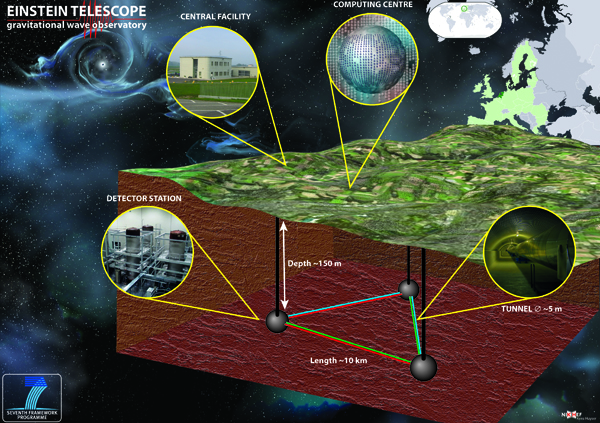
The 9th Einstein Telescope Symposium took place on 19-20th April, 2018 at the European Gravitational Observatory (EGO) in Cascina, Italy, where the Advanced Virgo gravitational-wave detector is situated.
Among more than 100 participants the APPEC (AstroParticle Physics European Consortium) and the LIGO (Laser Interferometer Gravitational-wave Observatory) were represented at the highest level.
On the first day, the plenary speakers reviewed the scientific potential and technology background of the third-generation gravitational wave observatories, and also a process has been started to strengthen the European cooperation – including also the terms and conditions for submitting an ESFRI (European Strategy Forum on Research Infrastructures) proposal for the projects to be lunched in 2020.
On the second day, invited representatives of the possible sites of the Einstein Telescope presented their efforts. The site at Limburg at the border area of Belgium-Netherlands-Germany and the Sardinian site were represented by Nikhef (Dutch National Institute for Subatomic Physics) and by INFN (Istituto Nazionale di Fisica Nucleare, Italy) respectively.
The results of the preparatory work in the Mátra Mountain in Hungary were presented by Mátyás Vasúth, the head of Gravity Research Group at MTA Wigner RCP (Wigner Research Centre for Physics at Hungarian Academy of Sciences) representing MTA Wigner RCP and MTA CsFK (Research Centre for Astronomy and Earth Sciences).
The Symposium has accepted a Letter of Intent (LoI) declaring the foundation of Einstein Telescope Consortium and invites the interested researchers to sign it, declaring their support for the establishment of ET and its scientific goals.
The presentations and the Letter of Intent are available via the following links:
https://events.ego-gw.it/indico/conferenceOtherViews.py?view=standard&c…
http://www.et-gw.eu/index.php/letter-of-intent
https://events.ego-gw.it/indico/conferenceOtherViews.py?view=standard&confId=64
http://www.et-gw.eu/index.php/9-et-symposium
The researchers of MTA Wigner RCP presented the results of measurements that have been conducted over the last two years in collaboration with Mátra Gravitational and Geophysical Laboratory (MGGL). The measurements have shown that Mátra is a seismically very ‘quite’ site and meets the requirements which were previously set for the building of the detector.
More precisely, the measurements proved that Mátra exhibits only a very low rate of seismic activity, and the magnitudes of earthquakes at the Hungarian site are very low as well. This is because of the fact that the volcanic rock blocks of Mátra Mountain are formed from andesite magma, and the formation of the andesite rocks lies on a limestone bed rock, which acts like a natural shock absorber.
The question of the depth of the detector - which will be built underground - has not been settled yet. The depth depends on the in-situ circumstances, but it is estimated to be built in the range of 50 and 200 meters depth. This is why continuous in-situ measurements of seismic activity performed by the MGGL are going to be particularly important in the following years.
The underground facility will host interferometers which will be arranged in the shape of equilateral triangle with 10-kilometre-long arms on each sides. In the preparation work in Hungary in addition to the Hungarian instrument a seismic sensor from Poland is also involved.
The Polish sensors have been measuring seismic noise at each of the possible sites in Europe: in Italy, Spain, Hungary and at the Belgian-Dutch-German tri-border area.
The Einstein Telescope is going to be built in European collaboration. It will be capable of detecting a large number of events which could mean several detections per day.
The present detectors were perfectly suitable for the purpose of the discovery of the gravitational waves. However, they were only able to carry out a few observations. By ET day-to-day observations will become possible - which allows the detection of new astrophysical sources of gravitational waves, such as rotating neutron stars, supernova explosions and currently unknown sources.
The gravitational waves provide information on strong gravitational phenomena that could contribute to the understanding of the relationship between gravity and quantum physics in the future.
By the development of the Einstein Telescope a number of technology is being developed, which could be utilized in the future in several other areas of life.
For the construction of the Einstein Telescope huge underground tunnels and caverns have to be excavated, similar to the size of tunnels of CERN.



